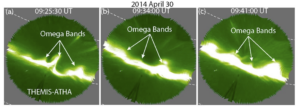As the only spatially resolved mapping of the interaction between the solar wind and the magnetosphere, the aurora are central to understanding the mechanisms of solar wind-magnetosphere-ionosphere coupling. Omega bands are mesoscale structures that emerge as eastward moving sinusoidal undulations of the poleward boundary of Earth’s equatorward auroral oval. They appear in the recovery phase of storms and substorms or during steady magnetospheric convection, and are known to be driven by sources in the solar wind or magnetosphere. However, the causes of these patterns are not well understood; open questions relate to both the driving solar wind conditions and the state and dynamic of the inner magnetosphere magnetically connected to these structures.
This research is a collaboration with Larry Kepko and Bea Gallardo-Lacourt from the NASA Goddard Space Flight Center. The figure below shows omega bands seen over Athabasca on April 30, 2014. Image courtesy of Bea Gallardo-Lacourt and Vivian Cribb.

